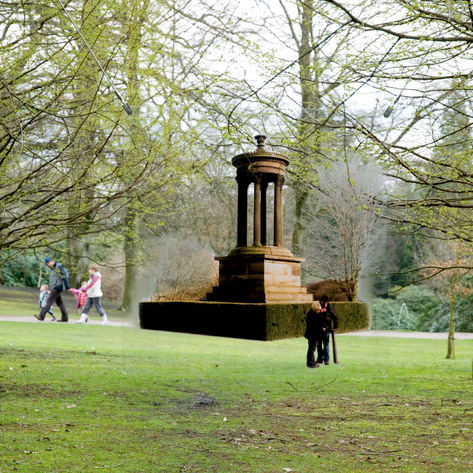Little Sheep
Date: 2nd May 2008A series of interventions seeking to challenge perceptions of manufactured landscape and its hierachy of elements and views.
There are many fascinating and intriguing elements to the grounds and the narratives that created them within the Tatton Park estate. The incremental devotion of time, money and vision to the gardens at Tatton, the family’s gradual rise to prominence and the eccentricities and insatiable collecting of Maurice Egerton. However, on visiting Tatton Park, I was overwhelmed by the effect of the abrupt ending of the lineage and the remarkable contradiction this offered to 500 years of ambition. The investment over generations was for many reasons, but I believe that one of these was the desire to secure the future status and importance of the family. Each generation held the house, gardens and family name in trust. They were charged with safe guarding and enhancing their integrity and importance. In a single life-time, Maurice added more to the diversity of the collections and the gardens than many of his predecessors, travelling the world and returning artefacts until his death and yet the endeavour was ultimately futile. There was no future generation to receive, catalogue, cherish and boast of his collection. The house, and the legacy were to lose their function at the moment of his death.
I am intrigued that Maurice continued to collect until his death despite the uncertainty as to the future of his collection. I find it fascinating that the burden that of expectation that had been passed on to him should have failed to cheat the inevitable irony of mortality.
On visiting Tatton I was privileged to view the Repton Red Book commissioned in 1791. His vision of enhanced nature was fascinating. He believed in four principles:
1. It must display the natural beauties and hide the defects of every situation.
2. It should give the appearance of extent and freedom by carefully hiding the boundary
3. It must studiously conceal every interference of art. However expensive by which the natural scenery is improved; making the whole appear the production of nature only;
4. All objects of mere convenience or comfort, if incapable of being made ornamental, or of becoming proper parts of the general scenery, must be removed or concealed.
The text is fascinating as it offered a step-by-step guide to grandeur. The design and manufacturing of greatness was Repton’s business and he unashamedly offered the secrets of historic importance to his clients. Sponsoring village pubs, churches and town halls to insist on prominence of the family crest, hiding boundary fences to enable an estate to appear larger than it actually was and creating approaches and avenues to enable the principle house to appear grander than it had previously been perceived. His ideas were innovative and at times comical in their candidness. At Tatton Park he advised the addition of sheep to draw the viewers eye beyond the bodies of water and to ensure that a true appreciation of scale was rendered to the visitor.
I proposed a series of modest continuations of the work of Repton. Although now too late for the Egertons to employ in their own aspirations to higher status, they could still serve to enable the viewer to question the authenticity of the views that they were enjoying. I proposed a small flock of miniature sheep to support a shift in perception of scale, a grand architectural folly and the addition of several elements retrieved from Maurice Egerton’s travels. At key Repton defined vistas the miniature sheep and other scaled elements, would be placed in the distance to encourage us to imagine an even greater landscape. Coloured to support aerial perspective, they would be placed to remind us that gardening is a constructed and heroic modification of nature, not merely the framing of territory.
The final installation retained the name Little Sheep but adopted the visual motif of the Choragic Monument as a recurrent element. Additional monuments were installed using a five colour printing process on suspended sheets of acrylic to interfere, modify, recontextualise and, at times parody, the vision of grandeur that Repton was never able to see realised.
Materials:5-colour digital print process on Acrylic, aluminium structures, tensioned cable, marine fittings and conservation tree-ties.


